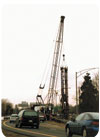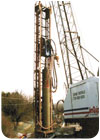
Syracuse Exploration Co. specializes in drilling bedrock shafts.
In order to construct a concrete sound barrier around Interstate 695 (the Baltimore beltway), JTE Inc. of Lorton, Va., was required to drill 300 pile holes 24 inches and 30 inches in diameter. To accomplish this, a two-step drilling procedure was employed using augers and down-hole hammers.
The first part of the procedure involved auger drilling a 30-inch diameter hole to a depth of 10 feet to 15 feet, or until hitting bedrock. The auger then was pulled out of the hole and casing was put down.
Auger drilling was abandoned, because trying to drill through bedrock with an auger has proven to be very labor-intensive and costly, due to its inability to efficiently fracture rock formations. Typically in these conditions, an auger has a tendency to break down and perform very slowly. To avoid this costly process, JTE contracted Syracuse Exploration Company (SEC), a drilling and consulting firm specializing in drilling bedrock shafts throughout the Eastern United States. The staff out of SEC's Mid-Atlantic office located in Hagerstown, Md., conducted the beltway project.

A unique drilling method was used on the sound barrier project.
“We chose the hammer not only for the product, but the support that we receive from Numa's staff. As a specialty drilling contractor, we often require special products and support, and Numa always is there for us,” says Jay DeLine, SEC president and CEO.
With the casing already down the hole, a Champion 240 hammer was lowered to the bedrock and drilled 24-inch diameter holes an additional 2 feet to 5 feet. Combining the rig's on-board air with an external 1,300/150 air compressor, the hammer was supplied with 1,800 cfm/150 psi of air and rotated at 12 rpm. This, coupled with injecting a mist of water to keep the dust down, enabled SEC to efficiently drill through the bedrock at a rate of 5 feet in 12 minutes - producing an average of 10 to 12 completed holes per day.

The job site was rather confined.
This breakthrough drilling technique involved the crane maneuvering and lowering the mast over each hole to be drilled. Once the mast was secured over the hole, the hammer was lowered down through the installed casing to drill into the bedrock. Supplied with 2,000 cfm/150 psi, the hammer was able to drill 7 feet in 15 minutes.
“We have tried others hammers for drilling bedrock shafts, but none could match the versatility and speed of the Numa down-hole hammer,” says Jay Deline.
The sound barrier project in Maryland has demonstrated how down-hole hammers can produce cost-effective results in the construction industry. There are endless drilling applications in the construction market for down-hole hammers whether it is shallow, deep, vertical or horizontal. But no matter what the product or conditions, a healthy bottom line always remains the benchmark of success. That is why the ability to reduce labor costs and increase profit margins is so important in the construction industry.
ND
Report Abusive Comment